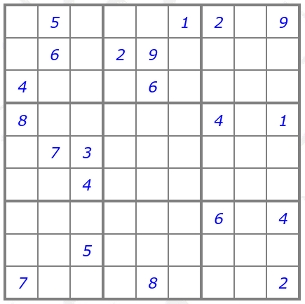Each value (1 through 9) must appear exactly once in each row.
Each value (1 through 9) must appear exactly once in each column.
Each value (1 through 9) must appear exactly once in each 3 x 3 sub-grid (or "square"), where the 9 x 9 board is divided into 9 such sub-grids.
A valid Sudoku game begins with initial numbers that, when
combined with the constraints above, admit exactly one
complete solution. That is, the initial numbers cannot make it
impossible to fill in the board legally, nor can they allow
multiple solutions. If you aren't familiar with
Sudoku, you can learn
more here or here.
The goal of this project is to write a Sudoku verifier.
A
verifier
accepts
an allegedly solved Sudoku grid (or partially solved grid) and
then verifies whether the solution is valid, according to the
rules above. (It does not have to ascertain whether a
solution is possible; only whether the current grid configuration
is legal.)
Write a program to perform
verification for a Sudoku board.

Write a JUnit test class and print the test source code and the successful test runner output.
Write a driver and a file of test input data. Print the driver source code, the input data file, and the execution output.
Perform any additional tests you want to convince yourself that your solution is correct.
In addition, your program must pass
the instructor's acceptance test. Once you are satisfied
that your program is correct and is passing your unit tests,
create a new time log entry. Enter "Test" for the phase and
in the comment field enter "Acceptance Testing". (You may
use "Accept Test" for the phase if you prefer. Do not count
this phase as development time in your summary).
Submit your source code using the Web-CAT grader. On this project the grader will not run your own unit tests. Web-CAT will report checkstyle errors in red and they WILL count in your total score. Each coding standard violation is a defect. The defect type is 10 for code syntax, and 80 for Javadoc errors. (Tip: To avoid getting style errors in Web-CAT, run the Checkstyle extension in BlueJ before submitting to Web-CAT.)
If Web-CAT reports any errors, tally
them in a new section of the defect tally without an inject phase,
with a removal phase of "ACCEPTANCE TEST". Don't add them to
Injected Phase or total on the Summary form. You are allowed five
Web-CAT submissions without penalty. If you take more than
five submissions, your project earns only half-credit.
When Web-CAT assigns a 100% score to your work, you should finalize your work according to the assignment directions.